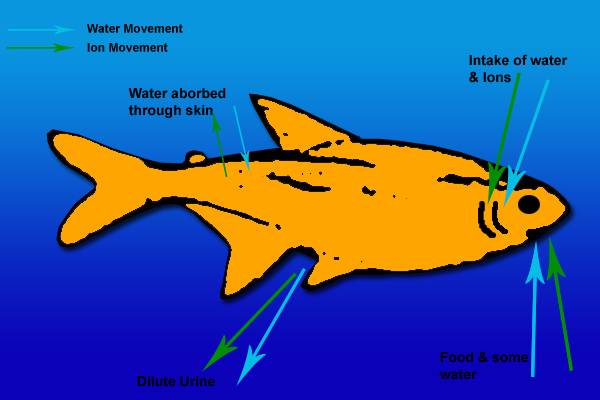The water your fish lives in is their primary source of survival. Cleanliness along with oxygen is vital. The minerals* including salt are important to keep a balance, this helps fish to do their OWN regulation of minerals internally. The more consistent water conditions, the healthier fish are. Do not make them work harder than they need to.
Osmosis is the process of when water enters a fish, and its concentration is adjusted. Salt water and freshwater fish ingest water differently due to their environment.
Osmoregulation
Osmoregulation is an internal balancing process that allows fish to make sure their levels of water and minerals (including salt) do not become too diluted or too concentrated regardless of environmental conditions. While humans have to drink water, fish are constantly surrounded by water and constantly take on, hold onto, or excrete water or salts to keep their internal water- mineral content stable.
This maintenance is known as proper osmotic concentration (osmolarity) of body fluids.How this process occurs depends on whether they are saltwater or freshwater fish. These minerals within water are selectively absorbed through an internal membrane. Only SOME ion, minerals and water can pass this internal barrier – known as a semi permeable membrane.
Gills are an example of this semi-permeable membrane.
Cytolysis
Freshwater fish are constantly losing minerals to the water around them. If there is not enough minerals in the water then Cytolysis will occur. Cytolysis occurs when too much water enters a cell. The pressure builds up in the cell making it expand to the point when it eventually bursts. This is referred to as Osmotic imbalance.
Waste Removal
Osmoregulation is achieved by excretory organs used also for the disposal of other wastes. Therefore, urination is for waste excretion and osmoregulation. A range of different organs do this function uniquely for different animals including salt glands and kidneys.
Fish must maintain the correct concentration of minerals and amount of water in their bodies in order to survive. To regulate hormones and other metabolic nitrogenous wastes, fish will excrete any excessive amounts of them through their skin and kidneys.
Salt water fish have to constantly be drinking and filtering out salt so as to not dehydrate. Freshwater fish however regulate how much water they are requiring to absorb at any given time avoiding their salt levels from getting too diluted. This means they urinate more than their saltwater counterparts. Makes you more aware of changing that tank water!
Osmotic Pressure
Water containing dissolved minerals naturally forces itself through the gills of a fish to equalize the outside body of water. This is known as osmotic pressure. To understand osmotic pressure when it comes to a freshwater fish, look at it internally and externally. The inside of the fish and the water outside of the fish.
Water is naturally attracted to the side with more salt on it – as salt naturally absorbs water. Freshwater fish are saltier than the water around them (Hyper osmotic), so the water is naturally being drawn into them. This constant flooding of water inside the fish forces salts out of its body due to osmoregulation. If not regulated correctly too much salt is lost then the fish will die. The fish has to constantly regulate its salt content to stay alive. Not enough salt in the water around them and they won’t have enough. Too much salt and they can not get rid of it quick enough.
The fish has to exert a lot of energy to regulate itself if the water around it suddenly changes, hence the importance of less extremes when transferring new fish into your tank. Fish tire more easily from the extra workload from the different conditions put on it. Even if it does adjust to the sudden changes, its immune system can weaken being prone to other diseases. Salt is great for reducing osmotic pressure and helping a fish fight diseases. Only use salt as a temporary solution for this and when transporting them.
Fish need time to adjust to any new water they are placed in. This is why when you bring your newly bought fish home from the aquarium shop and put them in your tank, they may die after a few days. They are trying to osmoregulate to their new environment. If the water is too different than where they have come from then eventually the osmotic pressure will be to great and Cytolysis will occur and the fish will die.
________________________________________
In conclusion fish need to adjust to their new environment slowly over a period of 2 – 3 days primarily because of how they absorb minerals and water. Keep in mind cleanliness, minerals, pressure and temperature affect all fish. Matching new tank conditions as close as possible to the water they are coming from will help them adjust more easily. Make sure they are also receiving the right balance of ions & minerals throughout their stay in your aquarium as this is also crucial to their long term health and survival.
* To simplify most uses of minerals also refer to ions.

